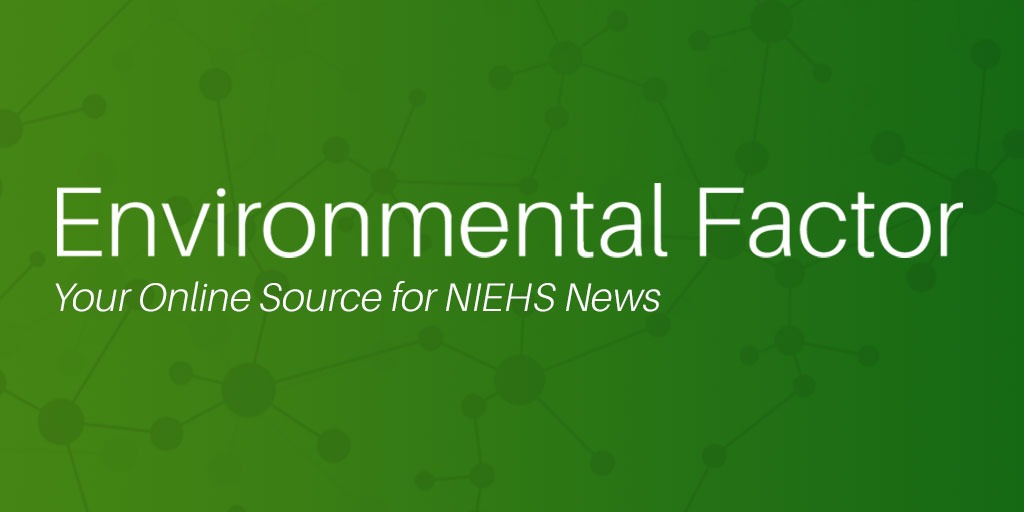Extramural
By Megan Avakian
Metals from e-cigarette aerosols accumulate in the brain
Mice exposed to e-cigarette aerosols had a buildup of toxic metals in the brain, according to NIEHS-funded researchers. The exposure also altered brain levels of essential metals, which play a key role in many biological processes. The findings provide clues about the onset of neurodegenerative diseases, which have been linked to toxic metal exposure and the dysregulation of essential metals.
The researchers exposed mice to either the equivalent of secondhand e-cigarette aerosol or a five-fold higher level for two months. They then measured levels of 15 different metals in brain and other central nervous system (CNS) tissues, such as the spinal cord.
Compared with unexposed mice, mice exposed to e-cigarette aerosol had significant buildup of several metals in the brain and CNS. Many of the metals that accumulated in exposed mice were known neurotoxins, including chromium, copper, iron, and lead. The number of metals and their concentrations in the brain were more pronounced in the high-dose group. The most striking changes in brain metal levels were in the striatum, which controls movement, action selection, and reward learning. Exposed mice also had reduced levels of some essential metals, such as selenium and zinc.
According to the authors, exposure to e-cigarette aerosol can increase deposition of neurotoxic metals in the brain and alter essential metal levels, potentially increasing the risk of neurodegenerative disease for both e-cigarette users and bystanders.
Citation: Re DB, Hilpert M, Saglimbeni B, Strait M, Ilievski V, Coady M, Talayero M, Wilmsen K, Chesnais H, Balac O, Glabonjat RA, Slavkovich V, Yan B, Graziano J, Navas-Acien A, Kleiman NJ. 2021. Exposure to e-cigarette aerosol over two months induces accumulation of neurotoxic metals and alteration of essential metals in mouse brain. Environ Res 202:111557.
Chemicals in consumer products increase hormones, breast cancer risk
A new NIEHS-funded study showed that exposure to nearly 300 common chemicals can cause cells to produce more estrogen or progesterone, which may increase breast cancer risk. Although many of these chemicals are used in consumer products, pesticides, and pharmaceuticals, they have not been evaluated for their cancer-causing potential.
The study included data for more than 650 chemicals tested in the U.S. Environmental Protection Agency’s ToxCast program. The researchers examined the data to identify chemicals that increased progesterone or estradiol, a form of estrogen, in a human cancer cell line.
Of the chemicals tested, 296 increased estradiol or progesterone in cells, whereas 71 chemicals increased both hormones. Using data from existing animal studies, the researchers then classified the hormone-increasing chemicals as either likely or unlikely to cause cancer or result in poor reproductive or developmental outcomes. Thirty percent were classified as likely carcinogens or reproductive or developmental toxicants, whereas only 5-13 percent were classified as unlikely to cause these health outcomes. The researchers identified 29 chemicals linked to both breast tumor development and increased progesterone or estradiol synthesis. However, most of the chemicals that increased hormone synthesis lacked sufficient data to gauge health effects.
According to the authors, this study identified several hundred chemicals that should be considered as breast cancer risk factors based on their ability to increase progesterone or estradiol.
Citation: Cardona B, Rudel RA. 2021. Application of an in vitro assay to identify chemicals that increase estradiol and progesterone synthesis and are potential breast cancer risk factors. Environ Health Perspect 129(7):77003.
Phthalate exposure linked to changes in sperm that can be passed to next generation
Male mice exposed to phthalates before conception had DNA methylation changes in sperm, which can be transferred to the next generation as altered gene expression in embryos, according to an NIEHS-funded study. DNA methylation occurs when a chemical compound, called a methyl group, attaches to DNA, affecting whether a gene is turned on or off.
The researchers exposed male mice to either a low or high level of di(2-ethylhexyl) phthalate (DEHP) for two sperm production cycles, or 67 days. Following exposure, they mated the mice with unexposed females. They then assessed genome-wide methylation in sperm, embryos, and extra-embryonic tissues, which support the developing embryo.
Compared with unexposed controls, paternal preconception DEHP exposure altered methylation in 704 sperm gene regions, 1,716 embryo gene regions, and 3,181 extra-embryonic gene regions. Of these, 29 gene regions overlapped between sperm and embryonic tissues, suggesting methylation changes related to paternal DEHP exposure may be transmitted to the next generation. The researchers also identified changes in gene expression in embryos in both exposure groups compared with controls. Many of the altered genes were related to pathways important in development.
According to the authors, results indicate that preconception is a sensitive window in which phthalate exposure alters sperm methylation and embryo gene expression in ways that may influence offspring health and development.
Citation: Oluwayiose OA, Marcho C, Wu H, Houle E, Krawetz SA, Suvorov A, Mager J, Richard Pilsner J. 2021. Paternal preconception phthalate exposure alters sperm methylome and embryonic programming. Environ Int 155:106693.
Topical therapy holds promise for blocking UV-induced skin cancer
NIEHS-funded researchers discovered that hypochlorous acid (HOCl) applied to the skin protected against the harmful effects of ultraviolet (UV) radiation. HOCl is a disinfectant commonly used to sanitize swimming pools and is found in some consumer products for skin disinfection.
The researchers profiled gene expression caused by short-term topical HOCl exposure in human reconstructed skin cells. HOCl significantly increased expression of genes related to the redox stress response, which controls many cellular functions and can stimulate a protective immune response. The researchers then exposed hairless mice to a combination of UV radiation and topical HOCl to mimic co-exposure often experienced by swimmers. HOCl blocked UV-induced inflammatory gene expression. In a co-exposure study in a second mouse model, often used to monitor health consequences of UV radiation exposure, HOCl reduced levels of the AP-1 protein by more than 50 percent. AP-1 is involved in skin inflammation and development of UV-induced skin cancer.
Next, the researchers exposed hairless mice to prolonged UV radiation, putting them at high risk for UV-related skin cancer. Mice given the HOCl treatment two weeks after UV exposure had a significantly lower tumor burden and reduced expression of inflammatory genes compared with untreated mice.
The study results demonstrate that topical HOCl applied at environmentally relevant exposure levels blocks UV-induced inflammatory gene expression, which provides a promising therapy for nonmelanoma skin cancer, according to the authors.
Citation: Jandova J, Snell J, Hua A, Dickinson S, Fimbres J, Wondrak GT. 2021. Topical hypochlorous acid (HOCl) blocks inflammatory gene expression and tumorigenic progression in UV-exposed SKH-1 high risk mouse skin. Redox Biol 45:102042.
Source link
factor.niehs.nih.gov


